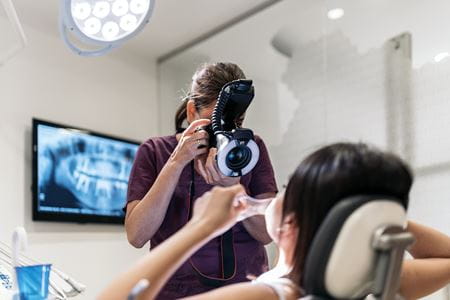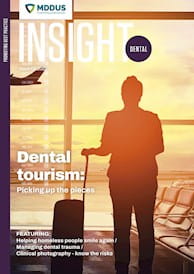 A PICTURE speaks a thousand words, as the old adage goes, and this is certainly true in dentistry.
A PICTURE speaks a thousand words, as the old adage goes, and this is certainly true in dentistry.
Clinical photography is a useful – and often essential – adjunct to dental treatment both pre-operatively and post-operatively. It is often far easier to capture important details using an image than relying solely on documentation in the clinical records.
But dentists who want to use photography do need to be mindful of key risk areas relating to:
- patient consent
- confidentiality
- use of an appropriate device.
Why use photography?
For many dentists, photography is part of everyday practice.
Clinicians may use it to monitor disease, to show the results of cosmetic treatment, to help with shade selection, build their portfolio, or for marketing purposes. It can also improve communication with a laboratory regarding the prescription for restorations.
It is helpful in patient education, for example showing a restoration with secondary caries or signs of tooth wear to a patient when discussing treatment options, or to accompany a referral for a suspicious lesion.
Having clear photos taken before the start of orthodontic, cosmetic or other dental treatment can be invaluable should the patient later complain about outcomes. In less common circumstances, photography can capture important evidence for a patient who presents as a victim of assault.
Consent
Before any images are taken, the first step is to get the patient’s consent and record this in their notes. The patient needs to have a clear understanding of what will happen to any clinical photos that are taken of them. The General Dental Council’s Standards guidance (at principle 4) is very clear about this.
Patients must be aware of how their personal information/images will be used and understand exactly what they are agreeing to.
Consent needs to be specific to each purpose. The patient must opt in for each usage, for example, whether photos will only be included in their clinical records, or whether they will also be used for teaching/education purposes, posted to social media or published elsewhere.
And remember that consent is required even if the photos are anonymised and the patient is not identified.
As with the sharing of all patient data, the minimum necessary should be used for the prescribed purpose and it should be explained to patients that their permission can be withdrawn at any time. It should be reaffirmed with the patient before taking any images if consent was given at a different appointment.
In addition to a dentist’s professional duty in relation to GDC guidance, they must also be sure to comply with GDPR/data protection laws. Patients are acutely aware of their rights in this area, and it is not uncommon for complaints to be accompanied by demands for deletion of data.
Written consent should be provided through the use of a consent form (preferably one that is specific to the patient’s circumstances) that is then scanned into the clinical records. Consent can be confirmed verbally where appropriate and documented in the clinical records.
Reaching for your phone
For time-pressured dental teams, quickly reaching for a personal mobile phone may seem like an easy way to take clinical photographs. But photos should ideally be taken on a dedicated device that is designated for clinical use only and stored securely.
Once the photo is uploaded into the clinical records it should be deleted from the device. This approach minimises the risk of photos being accessed by an unauthorised person, or the device being lost/stolen.
Failing to protect sensitive patient information would likely be considered a personal data breach by the Information Commissioner’s Office, with the potential for serious consequences for the practice.
The GDC also takes a dim view of such patient confidentiality breaches (at Standards principle 4.2). It is notable that the regulator specifically notes (at 4.2.9) that the duty to keep information confidential covers images, videos and audio recordings, “including those on a mobile phone". GDC guidance on the use of social media is also relevant here and reinforces the need for explicit consent.
Patient complaints
In some cases, a patient who was previously happy for their new smile to be published on the practice website or social channels may have cause to lodge a complaint against a member of the dental team. In such circumstances, it would seem sensible to remove their photos from public view.
Key points
Clinical photography has become a vital tool to enhance patient dental records, improve communication with colleagues and even give practices a marketing boost.
But remember that using an appropriate device is crucial to protect patient confidentiality.
As they form part of the clinical records, clinical photos must be securely stored, maintained and shared only with explicit consent.
This page was correct at the time of publication. Any guidance is intended as general guidance for members only. If you are a member and need specific advice relating to your own circumstances, please contact one of our advisers.
Read more from this issue of Insight Dental

Save this article
Save this article to a list of favourite articles which members can access in their account.
Save to library